Panzerfaust
WW II German Infantry Anti-Tank Weapons
Page 1: The Shaped Charge
Theory of the Shaped-Charge Warhead
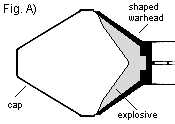 Before
we start with the different AT weapons I feel a word on the general mechanism
of a hollow- or shaped charge warhead is necessary for the understanding
of the weapons themselves.
Before
we start with the different AT weapons I feel a word on the general mechanism
of a hollow- or shaped charge warhead is necessary for the understanding
of the weapons themselves.
The theory of the shaped charge has probably been known since 1883, though
the first-ever military use of this concept in a conflict was the attack
on the belgian Fort "Eben Emael" by german troops on May 10th
1940.
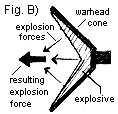 When
a shaped charge (see pic. A) detonates the energy is concentrated to the
center of the hollow space in front of and along the axis of the charge
(see simplified in pic.B). This phenomen, called the Monro - effect, is
still not completely understood in every detail. A forceful jetstream of
the explosion gases results that hits the steel target with a speed of
typically 8000 meters per second (26,000 fps) and penetrating pressure
in excess of 10 million kg/cm2 (3.4 mio.
pounds per square inch; other sources: 1.2 million kg/cm2
= 0.44 mio. pounds per square inch) (see pic.C). The effect
can be increased by putting a metal "liner" to the surface of
the hollow. When the explosion occurs, the liner metal is formed into a
spike of molten metal (although there is some discussion on whether it
is liquid or solid; most times it is referred to a "plasma" jet,
plasma not in the technical subatomic sense but in the sense of an in-between
state of the metal between liquiduous and solid). To be most effective,
the shaped charge has to be detonated at the right distance from the target.
If it detonates too close to the armor, the plasma-jet hasn't formed out
before hitting the surface and the effect is lessened somwewhat. If detonated
too far from the armor surface, the plasma jet has unfocused and partly
spent itself already (this effect is used in applying spaced armor, described
below).
When
a shaped charge (see pic. A) detonates the energy is concentrated to the
center of the hollow space in front of and along the axis of the charge
(see simplified in pic.B). This phenomen, called the Monro - effect, is
still not completely understood in every detail. A forceful jetstream of
the explosion gases results that hits the steel target with a speed of
typically 8000 meters per second (26,000 fps) and penetrating pressure
in excess of 10 million kg/cm2 (3.4 mio.
pounds per square inch; other sources: 1.2 million kg/cm2
= 0.44 mio. pounds per square inch) (see pic.C). The effect
can be increased by putting a metal "liner" to the surface of
the hollow. When the explosion occurs, the liner metal is formed into a
spike of molten metal (although there is some discussion on whether it
is liquid or solid; most times it is referred to a "plasma" jet,
plasma not in the technical subatomic sense but in the sense of an in-between
state of the metal between liquiduous and solid). To be most effective,
the shaped charge has to be detonated at the right distance from the target.
If it detonates too close to the armor, the plasma-jet hasn't formed out
before hitting the surface and the effect is lessened somwewhat. If detonated
too far from the armor surface, the plasma jet has unfocused and partly
spent itself already (this effect is used in applying spaced armor, described
below).
Because the effect is independent from the kinetic energy of the warhead,
it doesn't matter with which "carrier" the shaped charge is being
brought onto the target; both target range and weapon velocity are not
a factor, the charge can be literally laid onto the target and still have
the same devastating effect. 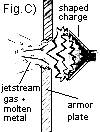 The
only variabels which effect the performance are the kind of explosive used,
the shape of the hollow cone and the distance to the target surface at
the moment of detonation.
The
only variabels which effect the performance are the kind of explosive used,
the shape of the hollow cone and the distance to the target surface at
the moment of detonation.
Another problem was that if stabilized during the flight by spin, that
spin would unfocus the detonation jet stream and hence increase its diameter
but lessen its force. Therefore shaped-charge projectiles should not be
stabilized during flight by means of spin as is the case with almost any
gun bullet or cannon round, but rather had to rely on small fins for some
degree of stabilization.The low speed and lack of powerful stabilization
make for an inherently rather inaccurate weapon that will deteriorate in
accuracy exponentially with range.
Still, because it didn't require a complicated apparatus to achieve a high-energy
muzzle velocity in order to work, the shaped charge was the ideal basis
for a cheap, lightweight close-range infantry AT weapon.
Composition of the German Shaped
Charges
The germans used code numbers to denominate the different explosives
developed and produced. The explosive material the germans used for the
shaped charges in the different AT weapons discussed on this site carried
the code explosive #96. This explosive #96 was a 50 : 50 mixture of the
explosives #14 and #104.
#14 was the explosives code for the standard Füllpulver 02,
better known as Trinitritoluene and abbreviated TNT. TNT
inherently lacks 70% of the oxygene it would need for a complete oxidationit's
during it's combustion/explosion; this is the reason why explosions from
munitions containing solely TNT make black dust clouds - soot. Because
of this it is favorable to combine it with other explosives such as Hexogene
that have an excess of inherent oxygene.
#104 was the explosives code for Hexogene, a Cyclotrimethylenetrinitramine
that is better known as RDX or Cyclonite. Hexogene is a very
effective explosive made up of Hexamethylenetetramine and Nitric Acid with
additions of Methanale, better known as Formaline, and Ammonium Nitrate.
Both TNT and Hexogene are highly toxic.
In some shaped charges (but not the Panzerfaust weapons themselves) the
mixture composition was changed to 60% TNT and 40% Hexogene, this combination
had the explosives - code-number #95.
To make for the critically important right detonation distance from
the target surface, often a hat or other extender was fixed to the front
of the shaped charge itself (see pic.A above).
Defeating Shaped Charge Munitions
Although the shaped charge is still in use today as a warhead for AT
weapons such as infantry RPGs and ATGMs as well as for multi-purpose tank
ammunition (HEAT - High Explosive Anti-Tank; despite it's name those rounds
are only against lightly armored APC's and as explosive charge ammunition;
modern tank guns rely on high-velocity SABOT kinetic energy penetrators
for fighting enemy tanks), even back in WW II armored vehicles weren't
completely helpless against this new technology and the resulting threat
posed by infantry carrying them. The problem could be approached by two
ways: through a) new tactics and b) new technology and hardware in the
farthest sense.
New Tactics
Even in the Finnish-Russian winter war it became apparent that isolated
tanks could be killed by daring infantry. Although the tanks had become
more sophisticated by then, the advent of potent AT weapons such as the
Panzerfaustnow completely prohibited the isolated use of tanks without
accompanying infantry. Combined arms tactics were vital more than ever.
New Hardware
The destructive force of an exploding hollow charge is concenztrated to
a relatively small area immediately to the front of the warhead. If this
pointed blowtorch - like explosion is slightly off course due to a unfavorable
impact angle, as sometimes happened on sloped and rounded surfaces (a problem
sometimes encountered in the employment of Faustpatrone warheads against
russian T-34 tanks), the detonation is used up more or less harmlessly
to the side of the armor.
The shaped charge will melt anything that comes in front of it. But only
for a short distance. The idea now is to simply prematurely detonate the
warhead at a safe distance from the actual armor. Any kind of spacing will
do, even air. The charge explodes harmelessly into the air between the
predetonating hardware and the actual armor. So even the air between a
thin metal shield for predetonating the warhead and the actual armor serves
as an actual increase in effective armor thickness.
Because this shield for predetonating the shaped charge is not meant
to be solid additional armor but merely meant as a trigger for the premature
explosion, any device that will serve this purpose will do, even mesh wire,
as we will see.
(Today, although spaced
armor is still used by armored vehicles, it is more common to employ
reactive armor against shaped charges: explosive reactive armor - little
boxes of explosives attached onto the actual armor - on the tank will explode
against the impacting shaped charge and therewith counter-force the warheads
explosion. This method seems to enjoy particular popularity among the russian
and israeli forces. Another approach is the use of heat-absorbing materials
as part of the composite armor that is made up of sandwich layers of different
materials including ceramics. Althoug conceived of as early as WW II by the germans, layered composite armor saw it's first widespread use when the british introduced their Chobham armor many decades after WW II; today such armor is widely used by most modern
heavy battle tanks in the west.) 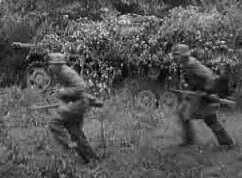
Germany
For the germans the coordination and cooperation between the different
arms a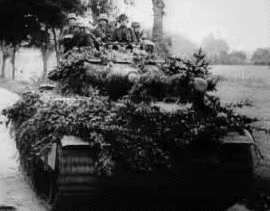 nd
weapons already were an integral part of their early-war Blitzkrieg tactics.
Later in the war a special kind of infantry was developed that was especially
trained in the cooperation with tanks. This new special branch of infantry
later even got their own suggestive name and were henceforth known as "Panzergrenadiere"
("Tank Infantrists"), a term still in use today to describe mechanized
infantry.
nd
weapons already were an integral part of their early-war Blitzkrieg tactics.
Later in the war a special kind of infantry was developed that was especially
trained in the cooperation with tanks. This new special branch of infantry
later even got their own suggestive name and were henceforth known as "Panzergrenadiere"
("Tank Infantrists"), a term still in use today to describe mechanized
infantry.
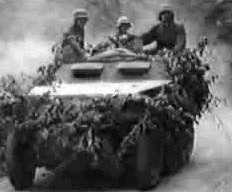 The
soldiers either rode on top of the tanks or kept pace with the highly mobile
armor units by using armored halftracks, the smaller "leichter
Schützenpanzerwagen" SdKfz 250 ("light armored
personnel carrier"; see picture) and the bigger "mittlerer
Schützenpanzerwagen" SdKfz 251 ("medium APC")
whenever available.
The
soldiers either rode on top of the tanks or kept pace with the highly mobile
armor units by using armored halftracks, the smaller "leichter
Schützenpanzerwagen" SdKfz 250 ("light armored
personnel carrier"; see picture) and the bigger "mittlerer
Schützenpanzerwagen" SdKfz 251 ("medium APC")
whenever available.
But the germans, who did a lot of development in the area of shaped-charge
infantry antitank weapons, knew very well of the potential threat these
weapons posed to armor and were conceiving methods to equip their armor
against that.
Zimmerit Coating 
To defend against the attachment of magnetic hollow charges (allied
counterparts of the Hafthohlladungen)
the germans developed the "Zimmerit" coating for their
tanks (more info on Zimmerit). Zimmerit consisted of about 40% Barium
Sulphate, 15% of ocre/sand pigment (=color), 10% Zinc Sulphide and 10%
glue mixed with sawdust; the remaining 25% were Mowilith, a polyvinyl-acetate.
The putty was applied onto the surface of a tank's armor in a first layer
that was about 5mm thick and a second layer 24h later which was 3mm thick.
The second coat was shaped inot large grooves giving the Zimmerit it's
distinctive look (see pic. at right: Jagpanzer IV with Zimmerit application).
The whole applied putty then was hardened using blowtorches.
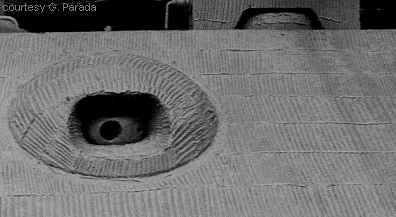 The
Zimmerit had no armor value whatsoever and therefore didn't really affect
the mechanism of the shaped charges themselves, it was simply meant as
a thick layer of nonmagnetic paste so that the magnets of attached hollow
charges wouldn't hold. The rough surface produced by the grooves was also
supposed to hamper the attachment of non-magnetic glue-based sticky mines.
Zimmerit was first introduced in 1943 on PzKpfw III tanks. Later all german
battle tanks received this treatment.
The
Zimmerit had no armor value whatsoever and therefore didn't really affect
the mechanism of the shaped charges themselves, it was simply meant as
a thick layer of nonmagnetic paste so that the magnets of attached hollow
charges wouldn't hold. The rough surface produced by the grooves was also
supposed to hamper the attachment of non-magnetic glue-based sticky mines.
Zimmerit was first introduced in 1943 on PzKpfw III tanks. Later all german
battle tanks received this treatment.
The picture at left shows the glacis of a PzKpfw V Panther (the bow machine
gun is missing).
Because the feared use of magnetically attached shaped charges by the allies
did not take place to a sufficient scale to justify the tedious procedure
of attaching zimmerit - esp. the expected use of such weapons by the russian
army never realized to a considerable degree -, the whole idea was abandoned
again in late fall 1944 (for the Pz V Panther coating was dropped in September
1944) and Zimmerit was from then on rarely added to new vehicles (to read
more about Zimmerit click here
and here).
Spaced Armor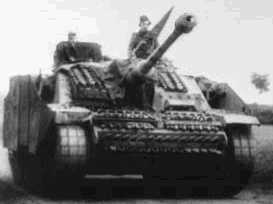
It was also realized that anything that would prematurely detonate the
shaped charge would greatly enhance armor protection against these weapons.
Anything, even the among tank crews popular adding of spare track parts
or wheels to the armor of tanks or additional crew stowage bins and equipment
affixed to the armor surface achieved this. The german tankers weren't
much different from tankers in the rest of the world in this respect. Spare
track parts can be seen most often attached especially to the front of
tanks. (picture at right: This late model StuG III can be seen with several strips
of spare track parts added to the front and with a full complement of lateral
Schürzen).
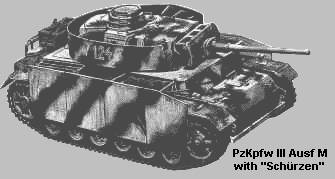 The
germans were the first to realize and standardize this effect. They fitted many tanks with the so-called Schürzen ("skirts").
The
germans were the first to realize and standardize this effect. They fitted many tanks with the so-called Schürzen ("skirts").
Note: There is some controversy over whether the skirts were developed as spaced armor, or whether they were added to improve overall armor rating against the russian AT rifles encountered in the east (the 14.5mm PTRD and PTRS). IMO it seems that although they were probably initially developed to aid defeat kinetic energy penetrators by increasing overall armor thickness, the potential of these spaced armor plates against hollow charge ammunitions was realized quickly and the concept of skirts was retained primarily for this side effect (as evidenced by the -albeit rather rare- use of mesh wire skirts, and application of skirts on armor surfaces that were practically immune from AT rifle fire, such as Panther side armor)
These Schürzen were thin steel plates or rather sheet metal added
to the main armor body of the hull and/or the turret at considerable distance. Thickness was 5mm, except for turret skirts which had 8mm thickness.
The picture at right shows a Pz III with a full set of Schürzen at
it's sides and around the turret.
The effect of this spaced armor was again the premature detonating of
shape-charge weapons that would explode into the air behind the Schürzen.
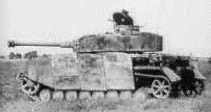
The flimsiness of the Schürzen is documented in the many reports of
Schürzen coming off in rough terrain or woods as shown in many pictures.
It was usual that one or more sections of the shields were missing on tanks in the field.
The picture at left shows a late model Pz IV with turret and side Schürzen,
notice the rightmost Schürzen - section is missing.
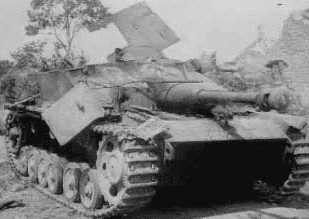 This picture shows a war-weary late StuG III with completely battered Schürzen
bent at odd angles.
This picture shows a war-weary late StuG III with completely battered Schürzen
bent at odd angles.
The Zimmerit coating addressed above was sometimes also applied to the
Schürzen.
 Soviet
Union
Soviet
Union
The Soviet Union's Red Army is widely known for it's extensive use of tank-riding
infantry. Originally, the close coordination with the infantry was the
only way for the russians to protect their tanks to a degree from the new
german weapons. Russian tanks too often had spare track parts attached
to the front and/or forward hull sides.
But the russians also developed their own solutions to this problem
in the forms of shields similar to the german's Schürzen. Some of
these were solid thin metal plates while others were simply mesh-wire frames.
Just like the german mesh wire - application this sufficed for the purpose
of posing an obstacle for prematurely detonating a shaped charge warhead.
Both kinds of shields were mass-produced factory items. The rumor that
the russians also installed improvised spaced armor with common bedsprings
is wrong and might stem from a misinterpretation of the pictures showing the mesh-wire type of shields.
misinterpretation of the pictures showing the mesh-wire type of shields.
The picture at left shows a russian T-34/85 with the mesh-wire type shields
in front of the Reichstag in Berlin, date April 1945. The same vehicle
is shown below in a drawing.


This rare picture at right shows the solid-type shields attached to
an IS tank destroyer. This picture nicely illustrates the considerable
spacing between the shield and the main armor.
The russians introduced their shields rather late in the war; also contrary
to the germans who applied the Schürzen onto if not all then most
of their tanks, the russian's shields don't seem to have been used as widely.
(these pictures have been contributed by courtesy of the
Russian Military Zone, an
excellent authoritative site on russian WW II tanks and AFVs)
Western Allies 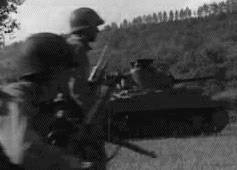
The western allies, especially the americans and the british, encountered Panzerfaust
weapons en masse ever since setting foot to european continent soil in
their invasion in Normandy; the deadly potential of these weapons became
apparent immediately behind the beaches in the fighting in the famous bocage terrain of Normandy.
the beaches in the fighting in the famous bocage terrain of Normandy.
The americans too countered this threat at first by developing new
tactics that emphasized the close coordination between tanks and infantry.
Later, the fast moving tank units that advanced into german-held territory
were accompanied by infantry that kept up with the speed of the armored
spearheads in their armored halftrack APC's. Also, american troops too
could be seen riding on the tanks. 
Although the americans didn't develop spaced armor for their tanks in
a standardized or mass-produced way, their crews excelled at improvising
and overcoming this by adding all sorts of additional armor themselves.
Also, in the way that german tanks are associated with Schürzen
and russian tanks are associated with infantry riding on them,  the
american tankers are known for their gratuitous loading of all kinds of
accessories onto their vehicles.
the
american tankers are known for their gratuitous loading of all kinds of
accessories onto their vehicles.
Sandbagging and especially the attachment of spare tracks seem to have
enjoyed particular popularity.
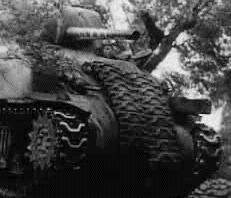
The light tank Stuart M 5 shown in the picture at right has a considerable
amount of sandbags loaded to it's front and also features spare track attached
to the turret sides.
The M4 Shermans at left and below both have two rows of spare track
added to their front.

This improvised "spaced armor" in the form of additional track
parts, stowage bins etc. however cuts both ways.
On one hand, any track or spare wheel steel that an enemy round or a shaped
charge has to plow through increases the effective armor thickness.
On the other side, such accessories served as projectile catchers for rounds
that would otherwise maybe have ricocheted off the slope of the armor.
This problem does not apply to shaped charges to the same degree that it
affects KE (kinetic energy) projectiles (i.e., regular tank AP projectiles).
It is hard to decide whether this drawback offsets the advantages of
providing some additional layer of armor. In terms of shaped charges the
additional tank tracks, wood crates etc. certainly were valuable (however
these often would still not suffice to  stop
the hollow charge munitions). It seems however that at least the american
tank crews felt they were better off attaching these things than leaving
their tank clean; it was their lives who were at stake, so they should
know best and who are we to second-guess them.
stop
the hollow charge munitions). It seems however that at least the american
tank crews felt they were better off attaching these things than leaving
their tank clean; it was their lives who were at stake, so they should
know best and who are we to second-guess them.
Another almost standardized method was the construction of a wooden
frame that encompassed the front and sides of the vehicle and held in place
a thick layer of sandbags, as shown in the illustration at left of an M4E3A8
"Easy Eight" Sherman.
Although far from being an official item, these constructions are the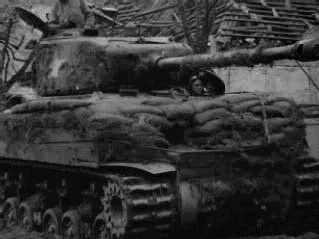 closest of being an eqiuivalent to the german and russian shields in terms
of effect and of being common practice.
closest of being an eqiuivalent to the german and russian shields in terms
of effect and of being common practice.
Besides providing for a wide space from the actual main armor, the filling
of the sandbags (sand) made for a relatively good material against hollow
charge explosions.
These wooden frames were unique constructions; on this other late war
picture of an M4A3E8 shown at right the gratuitous amount of sandbags is
laterally held in place by wooden panels nailed together.

This rather blurry picture of an M4 Sherman (a late WW II picture, notice
the wide tracks) shows that even bundles of tree logs were used! If you
carefully look at the side of the tank, you can also see the additional
armor patches that were welded over critical parts of the tank's armor.

Another factory way of increasing the frontal armor was the increase
of the armor itself. Many shermans were converted into the so-called "Jumbo"
variant that featured a very thick front armor. On other shermans used
for assault purposes, a thick layer of concrete was cast onto the front
hull.

This last picture shows an M10 Tank destroyer in use with the british
forces, where it was called Achilles. It illustrates that the practice
of adding spare tracks, spare wheels and other things to the armor to increase
protection wasn't limited to the german, russian or american forces; rather,
this is a habit that is found among tankers everywhere in the world.
A last interesting fact is that towards the end of the war the british
thought about using the german Zimmerit coating for their tanks, too. After
the german collapse a team was sent to germany to investigate the manufacturinmg
of Zimmerit for the possible use onm british tanks in the Pacific against
the still fighting japanese. The war ended before any of this realized.
(You can read more about the british investigation here).
Previous
Page : Main Page
Main Page
Next Page : Faustpatrone & Panzerfaust
© 1998, 1999, 2000, 2001, 2002 created by M.Hofbauer August
29th 1998; document ver. 1.4a mod 121102
This page has been constructed with own material as far
as possible, the third party images and information used herein are public
domain to the best of my knowledge. The author went to considerable lengths
to ensure accordance with the rights of copyright owners where applicable;
respective consent is documented. If you feel injured in your rights by
/ take offense at - any part of this page's content contact
me immediately for redress / possible removal of the respective part.
 Before
we start with the different AT weapons I feel a word on the general mechanism
of a hollow- or shaped charge warhead is necessary for the understanding
of the weapons themselves.
Before
we start with the different AT weapons I feel a word on the general mechanism
of a hollow- or shaped charge warhead is necessary for the understanding
of the weapons themselves.  When
a shaped charge (see pic. A) detonates the energy is concentrated to the
center of the hollow space in front of and along the axis of the charge
(see simplified in pic.B). This phenomen, called the Monro - effect, is
still not completely understood in every detail. A forceful jetstream of
the explosion gases results that hits the steel target with a speed of
typically 8000 meters per second (26,000 fps) and penetrating pressure
in excess of 10 million kg/cm2 (3.4 mio.
pounds per square inch; other sources: 1.2 million kg/cm2
= 0.44 mio. pounds per square inch) (see pic.C). The effect
can be increased by putting a metal "liner" to the surface of
the hollow. When the explosion occurs, the liner metal is formed into a
spike of molten metal (although there is some discussion on whether it
is liquid or solid; most times it is referred to a "plasma" jet,
plasma not in the technical subatomic sense but in the sense of an in-between
state of the metal between liquiduous and solid). To be most effective,
the shaped charge has to be detonated at the right distance from the target.
If it detonates too close to the armor, the plasma-jet hasn't formed out
before hitting the surface and the effect is lessened somwewhat. If detonated
too far from the armor surface, the plasma jet has unfocused and partly
spent itself already (this effect is used in applying spaced armor, described
below).
When
a shaped charge (see pic. A) detonates the energy is concentrated to the
center of the hollow space in front of and along the axis of the charge
(see simplified in pic.B). This phenomen, called the Monro - effect, is
still not completely understood in every detail. A forceful jetstream of
the explosion gases results that hits the steel target with a speed of
typically 8000 meters per second (26,000 fps) and penetrating pressure
in excess of 10 million kg/cm2 (3.4 mio.
pounds per square inch; other sources: 1.2 million kg/cm2
= 0.44 mio. pounds per square inch) (see pic.C). The effect
can be increased by putting a metal "liner" to the surface of
the hollow. When the explosion occurs, the liner metal is formed into a
spike of molten metal (although there is some discussion on whether it
is liquid or solid; most times it is referred to a "plasma" jet,
plasma not in the technical subatomic sense but in the sense of an in-between
state of the metal between liquiduous and solid). To be most effective,
the shaped charge has to be detonated at the right distance from the target.
If it detonates too close to the armor, the plasma-jet hasn't formed out
before hitting the surface and the effect is lessened somwewhat. If detonated
too far from the armor surface, the plasma jet has unfocused and partly
spent itself already (this effect is used in applying spaced armor, described
below).  The
only variabels which effect the performance are the kind of explosive used,
the shape of the hollow cone and the distance to the target surface at
the moment of detonation.
The
only variabels which effect the performance are the kind of explosive used,
the shape of the hollow cone and the distance to the target surface at
the moment of detonation. 
 nd
weapons already were an integral part of their early-war Blitzkrieg tactics.
Later in the war a special kind of infantry was developed that was especially
trained in the cooperation with tanks. This new special branch of infantry
later even got their own suggestive name and were henceforth known as "Panzergrenadiere"
("Tank Infantrists"), a term still in use today to describe mechanized
infantry.
nd
weapons already were an integral part of their early-war Blitzkrieg tactics.
Later in the war a special kind of infantry was developed that was especially
trained in the cooperation with tanks. This new special branch of infantry
later even got their own suggestive name and were henceforth known as "Panzergrenadiere"
("Tank Infantrists"), a term still in use today to describe mechanized
infantry.  The
soldiers either rode on top of the tanks or kept pace with the highly mobile
armor units by using armored halftracks, the smaller "leichter
Schützenpanzerwagen" SdKfz 250 ("light armored
personnel carrier"; see picture) and the bigger "mittlerer
Schützenpanzerwagen" SdKfz 251 ("medium APC")
whenever available.
The
soldiers either rode on top of the tanks or kept pace with the highly mobile
armor units by using armored halftracks, the smaller "leichter
Schützenpanzerwagen" SdKfz 250 ("light armored
personnel carrier"; see picture) and the bigger "mittlerer
Schützenpanzerwagen" SdKfz 251 ("medium APC")
whenever available. 
 The
Zimmerit had no armor value whatsoever and therefore didn't really affect
the mechanism of the shaped charges themselves, it was simply meant as
a thick layer of nonmagnetic paste so that the magnets of attached hollow
charges wouldn't hold. The rough surface produced by the grooves was also
supposed to hamper the attachment of non-magnetic glue-based sticky mines.
Zimmerit was first introduced in 1943 on PzKpfw III tanks. Later all german
battle tanks received this treatment.
The
Zimmerit had no armor value whatsoever and therefore didn't really affect
the mechanism of the shaped charges themselves, it was simply meant as
a thick layer of nonmagnetic paste so that the magnets of attached hollow
charges wouldn't hold. The rough surface produced by the grooves was also
supposed to hamper the attachment of non-magnetic glue-based sticky mines.
Zimmerit was first introduced in 1943 on PzKpfw III tanks. Later all german
battle tanks received this treatment. 
 The
germans were the first to realize and standardize this effect. They fitted many tanks with the so-called Schürzen ("skirts").
The
germans were the first to realize and standardize this effect. They fitted many tanks with the so-called Schürzen ("skirts"). 
 This picture shows a war-weary late StuG III with completely battered Schürzen
bent at odd angles.
This picture shows a war-weary late StuG III with completely battered Schürzen
bent at odd angles. 




 the beaches in the fighting in the famous bocage terrain of Normandy.
the beaches in the fighting in the famous bocage terrain of Normandy. 
 the
american tankers are known for their gratuitous loading of all kinds of
accessories onto their vehicles.
the
american tankers are known for their gratuitous loading of all kinds of
accessories onto their vehicles. 

 stop
the hollow charge munitions). It seems however that at least the american
tank crews felt they were better off attaching these things than leaving
their tank clean; it was their lives who were at stake, so they should
know best and who are we to second-guess them.
stop
the hollow charge munitions). It seems however that at least the american
tank crews felt they were better off attaching these things than leaving
their tank clean; it was their lives who were at stake, so they should
know best and who are we to second-guess them.  closest of being an eqiuivalent to the german and russian shields in terms
of effect and of being common practice.
closest of being an eqiuivalent to the german and russian shields in terms
of effect and of being common practice. 

